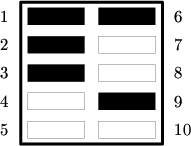Difference between revisions of "1988 AIME Problems/Problem 1"
Mathcool2009 (talk | contribs) (→Solution) |
Mathcool2009 (talk | contribs) (→Solution) |
||
| Line 8: | Line 8: | ||
With any integer <math>x</math> from <math>1</math> to <math>9</math>, the number of ways to choose a set of <math>x</math> buttons is <math>\sum^{9}_{k=1}{10 \choose k}</math>. | With any integer <math>x</math> from <math>1</math> to <math>9</math>, the number of ways to choose a set of <math>x</math> buttons is <math>\sum^{9}_{k=1}{10 \choose k}</math>. | ||
Now we can use the identity <math>\sum^{n}_{k=0}{n \choose k}=2^{n}</math>. | Now we can use the identity <math>\sum^{n}_{k=0}{n \choose k}=2^{n}</math>. | ||
| − | So the number of | + | So the number of additional combinations is just |
<math>2^{10}-{10\choose 0}-{10\choose 10}-{10 \choose 5}=1024-1-1-252=\boxed{770}</math>. | <math>2^{10}-{10\choose 0}-{10\choose 10}-{10 \choose 5}=1024-1-1-252=\boxed{770}</math>. | ||
Revision as of 00:18, 6 June 2014
Problem
One commercially available ten-button lock may be opened by depressing -- in any order -- the correct five buttons. The sample shown below has ![]() as its combination. Suppose that these locks are redesigned so that sets of as many as nine buttons or as few as one button could serve as combinations. How many additional combinations would this allow?
as its combination. Suppose that these locks are redesigned so that sets of as many as nine buttons or as few as one button could serve as combinations. How many additional combinations would this allow?
Solution
Currently there are ![]() possible combinations.
With any integer
possible combinations.
With any integer ![]() from
from ![]() to
to ![]() , the number of ways to choose a set of
, the number of ways to choose a set of ![]() buttons is
buttons is  .
Now we can use the identity
.
Now we can use the identity  .
So the number of additional combinations is just
.
So the number of additional combinations is just
 .
.
See also
| 1988 AIME (Problems • Answer Key • Resources) | ||
| Preceded by First Question |
Followed by Problem 2 | |
| 1 • 2 • 3 • 4 • 5 • 6 • 7 • 8 • 9 • 10 • 11 • 12 • 13 • 14 • 15 | ||
| All AIME Problems and Solutions | ||
The problems on this page are copyrighted by the Mathematical Association of America's American Mathematics Competitions. 










